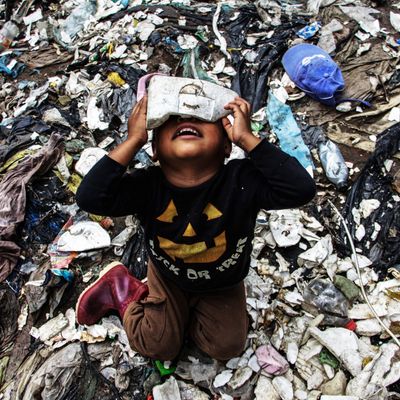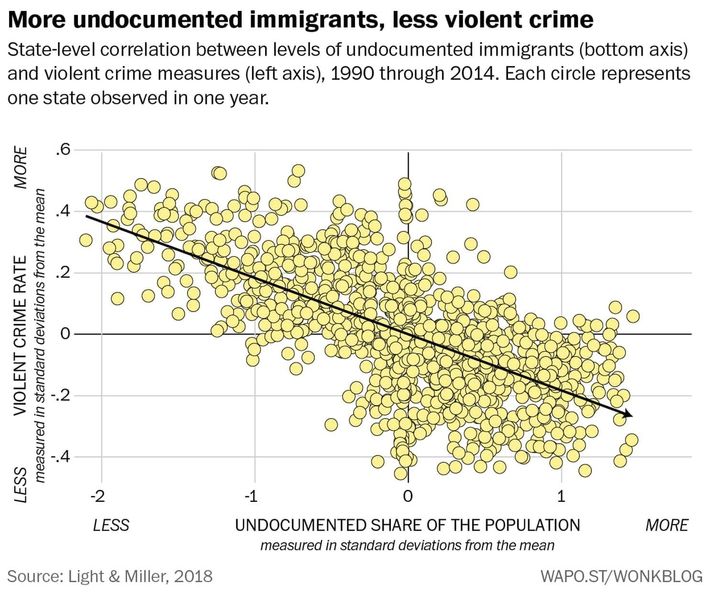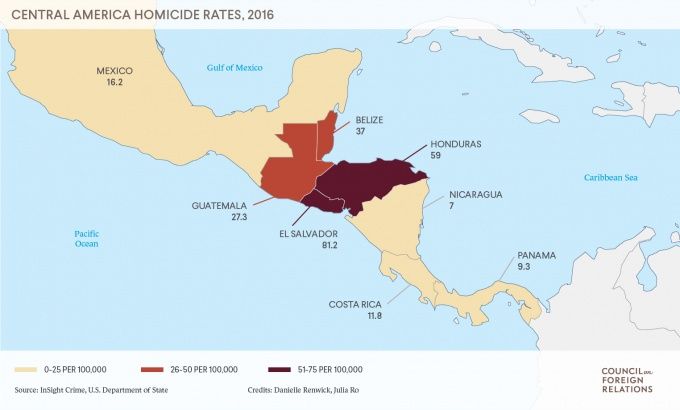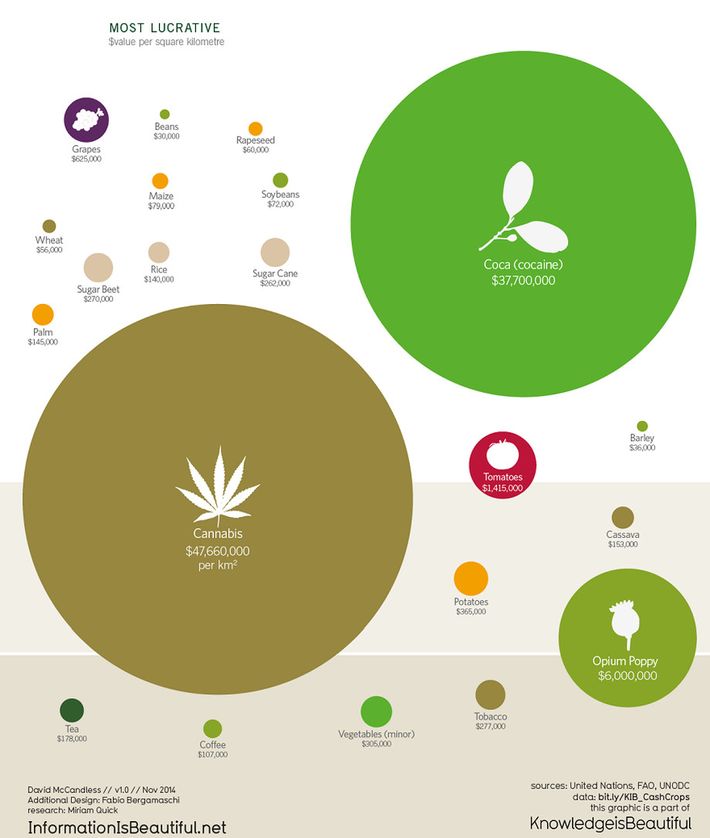
There is now a broad, bipartisan consensus that ripping infants from their mothers — and then putting both in (separate) cages — is not a morally acceptable way of treating families who cross our southern border. After weeks of deliberation, our nation has concluded that Central American migrants do not deserve to have their children psychologically tortured by agents of the state.
But what they do deserve remains in dispute.
The White House contends that migrants have a right to be caged with their family members (except for those who have already been separated from their children, who aren’t necessarily entitled to ever see their kids again). But the judiciary says that child migrants have a right not to be caged, at all. And progressives seem to believe that these huddled masses are entitled to something more — though few have specified precisely what or why.
In defending its “zero tolerance” policy — which is to say, a policy of jailing asylum-seekers for the misdemeanor offense of crossing the U.S. border between official points of entry — the White House has implored its critics to consider the bigger picture: Such “illegal aliens” have already undermined the rule of law in our country, and brought drugs, violent crime, and MS-13 to our streets. Locking up their families might look cruel when viewed in isolation; but when understood in the broader context of a migrant crisis that threatens the safety and sovereignty of the American people, the policy is more than justified.
In reality, however, this narrative inverts the truth: Context does not excuse the cruelty of our government’s “zero tolerance” policy, it indicts that policy even further. The United States is not suffering a crisis that justifies radical measures; the Central American families gathered at our border are. And those families aren’t bringing crime and lawlessness to our country — if anything, we brought such conditions to theirs.
After all, it was the CIA that overthrew the democratically elected government of Guatemala in 1954, and thereby subjected its people to decades of dictatorship and civil war. It was the streets and prisons of California that gave birth to MS-13, and American immigration authorities that deported that gang back to El Salvador. And it is America’s taste for narcotics that sustains the drug trade in Honduras — and our war on drugs that ensures such trade is conducted by immensely profitable and violent cartels.
There is no easy answer to the Central American migrant crisis. But any remotely moral policy response will need to proceed from the recognition that we are not the victims of this crisis — and asylum-seekers are not its creators.
Central American families are not a threat to the United States.
It is very hard to make a reasoned case for why our nation’s current levels of undocumented immigration — or, of low-skilled immigration more broadly — represent major threats to the safety and material well-being of the American people.
We have long known that native-born Americans commit violent crimes at far higher rates than either legal or undocumented immigrants. And newer research into immigration and criminality has proven even more devastating to the nativists’ case: States with higher concentrations of undocumented immigrants tend to have lower rates of violent crime — and this correlation persists even when controlling for a given state’s median age, level of urbanization, and rate of unemployment or incarceration.

Meanwhile, the American economy is in great need of young, unskilled workers. On the Labor Department’s list of the 15 occupations that will experience the fastest growth over the next six years, eight require no advanced education. Further, with the baby-boomers retiring — and birth rates plummeting — the future of American economic growth, and the survival of Social Security, depends on an infusion of foreign workers. It is true that there is some basis for believing that mass, low-skill immigration depresses the wages of native-born high-school dropouts (although that claim is contentious). But there is no basis for believing that restricting immigration will do more to boost such workers’ take-home pay than encouraging unionization through labor-law reform, or expanding the Earned Income Tax Credit (EITC). Thus, given the positive material benefits of mass low-skill immigration, it is hard to see how more of it would constitute an economic crisis, even if we stipulate that it puts downward pressure on the wages of some native-born workers.
By contrast, the crisis facing the migrants themselves is wrenching and undeniable.
Asylum-seekers are fleeing violence and disorder, not exporting it.
To seek asylum in the United States, Central American families must travel many hundreds of miles through the desert, along a route teeming with rapists, thieves, and homicidal gangs. The hazards inherent to this journey aren’t unknown to most who take it — such migrants simply find the hazards of remaining in place more intolerable.
And that calculation isn’t hard to understand. El Salvador, Guatemala, and Honduras endure some of the highest rates of violent crime — and levels of official corruption — of any nations in the world. As recently as 2015, El Salvador was the single-most violent country (that wasn’t at war) on planet Earth, with a homicide rate of 103 per 100,000. And the vast majority of those homicides went unpunished — according to a 2017 report from the Georgetown Security Studies Review, roughly 90 percent of murders throughout the Northern Triangle go unprosecuted. This lawlessness is both a cause and effect of widespread public distrust in state police forces, which are largely non-professionalized, frequently penetrated by criminal gangs, and historically associated with atrocities carried out in times of political unrest and civil war.

Public trust in the region’s other governing institutions is similarly, justifiably, low. Due to corruption and bureaucratic inefficacy, nations in the Northern Triangle collect less in tax revenues than most other Latin American countries (relative to the size of each nation’s gross domestic product). This fact, combined with high levels of spending on (grossly underperforming) security forces leaves the region’s governments with little funding for social services and public investment. And corruption eats into what meager funding is allocated to such purposes — in Honduras, the ruling National Party has been accused of embezzling social security funds; Guatemala’s former president and nine of his ex-ministers were arrested in February for graft connected to a public transit project.
While the region’s governments have struggled to collect taxes, its drug cartels have proven quite effective at collecting tribute. In 2015, the Honduran newspaper La Prensa revealed that citizens of El Salvador, Honduras, and Guatemala were collectively making more than $651 million in extortion payments to criminal organizations annually. Those who fail to pay up are routinely murdered; many of the migrants seeking asylum in the U.S. claim (quite credibly) to be fleeing such homicidal extortion rackets.
So, these migrants are fleeing a genuine crisis. But that does not necessarily mean that our country has any special obligation to address their plight. The U.S. government is not forcing the Northern Triangle’s political and economic elites to engage in graft, or avoid taxes. It does not pay the region’s police to let murders go unsolved, or (directly) sell weapons to the region’s cartels. In fact, Congress has spent more than $3 billion on security aid for Central America over the past decade.
And yet, the United States still bears profound responsibility for the region’s troubles; because the Northern Triangle’s failures of governance — and wrenching security challenges — are inextricably-linked to our nation’s policy choices and consumption habits.
On the former point: The CIA subjected Guatemala to decades of authoritarian rule and civil war, for the sake of aiding a fruit company that its director was invested in.
In 1945, a revolutionary movement built a representative democracy in Guatemala. Nine years later, the United States tore it down. Officially, the Eisenhower administration orchestrated the overthrow of Jacobo Árbenz’s government to save the Guatemalan people from Communist tyranny. In reality, it did so to deny them popular sovereignty.
Árbenz had been democratically elected, and enjoyed widespread public support. He had legalized the Communist Party, but was no card-carrying member. His crime was not the suppression of dissent or the suspension of constitutional rule — but rather, an attempt to address his nation’s wrenching inequality by redistributing the United Fruit Company’s (UFC) unused land to impoverished peasants.
This was not an act of pure expropriation — the UFC had robbed the Guatemalan government of tax revenue, by vastly understating the value of its holdings. By seizing the company’s unused lands, Árbenz secured a measure of compensation for his state; and, more importantly, provided 100,000 Guatemalan families with land, and access to credit. Agricultural production increased, poverty fell. Árbenz’s constituents were pleased.
But the United Fruit Company was not. And both Secretary of State John Dulles and his brother, CIA director Allen Dulles had close ties to the UFC. So, our government took out Árbenz, and replaced him with a reactionary, former military officer — who promptly assumed dictatorial powers. Nearly four decades of civil war between authoritarian governments and left-wing guerrillas ensued — throughout which the United States provided support to the former. By the time the fighting ended in 1996, 200,000 people were dead.
It is impossible to know what life in Guatemala would be like today absent the CIA’s intervention. One can imagine Árbenz’s democracy thriving through the second half of the 20th century, and serving as a model for its neighbors in the Northern Triangle. One can also imagine less rosy counterfactuals. What we know for certain is that the United States deliberately undermined the national sovereignty of Guatemala and inadvertently triggered decades of civil war. And we know that said civil war left in its wake large groups of demobilized men with experience in killing, and access to (often, U.S.-made) military-grade weapons — and that many of those men ended up forming violent, criminal organizations that plague the Northern Triangle today.
And American drug users and policymakers sustain those criminal organizations.
Demand for narcotics is overwhelmingly concentrated in prosperous, developed countries; which means, in the Western Hemisphere, it is overwhelmingly concentrated in the United States. And the U.S. government’s Draconian (and profoundly ineffective) approach to reducing that demand has only inflated the profits that Central American criminal organizations can reap by satisfying our illicit appetites. As German Lopez reported for Vox in 2014:
These drugs cost pennies by the dose to produce, but their value is increased through the supply chain to reflect the risk of losing a harvest to drug-busting government officials or rival criminal organizations.
The inflated cost creates a huge financial incentive for criminal organizations to get into the business of drugs, no matter the risks. They might lose some of their product along the way, but any product that makes it through is immensely profitable.
Criminal groups would likely take up other activities — human trafficking, kidnapping, gun smuggling, extortion — if the drug market didn’t exist. But experts argue drugs are uniquely profitable and empower criminal organizations in a way no other market can.

One could argue that the downside risks of legalizing hard drugs justify the harms inherent to their prohibition. The fact that the United States refuses to remove marijuana from the black market — and thus, deny cartels a major profit source — is harder to justify. But either way, it remains the case that the costs of our nation’s consumption — and prohibition — of drugs fall heaviest on our neighbors to the south. In fact, some have even argued that America’s drug habit is responsible for nearly all of the violence in the Northern Triangle — among them, White House chief of staff John Kelly.
“There are some in officialdom who argue that not 100 percent of the violence [in Central America] today is due to the drug flow to the U.S.,” Kelly wrote in 2014, when he was serving as Southcom commander. “I agree, but I would say that perhaps 80 percent of it is.”
MS-13 was born in the U.S.A.
Donald Trump has accused Central American governments of “sending” their most violent and criminal residents to the United States — including the homicidal gangsters of MS-13. In truth, of course, the vast majority of migrants from Central America are self-selected and nonviolent.
But Trump’s mistake is almost understandable: After all, the U.S. government actually has sent some of its most violent and criminal residents to Central America: MS-13 was formed on the streets of Los Angeles, hardened in American prisons, and then deported back to the Northern Triangle.
True, the gang’s original members were (mostly unauthorized) Salvadoran immigrants who’d fled their nation’s civil war. But those immigrants arrived in California as troubled teenagers, not sadistic killers. Dara Lind offers a concise sketch of the competing theories for how some of them became the latter:
[The Salvadoran teens] faced hostility from other ethnic groups for being new, and from other young people for being long-haired mosher types, so they banded together and called themselves the Stoners — later Mara Salvatrucha, and eventually, once the gang had metastasized under the network of Southern California Latino gangs known as Sureños, MS-13.
When and why the “Stoners” became a hardened violent gang is up for debate. Avalos attributes it to repeated confrontations with other LA gangs, while journalist Ioan Grillo thinks it has more to do with the arrival of newer Salvadoran immigrants who were “hardened by the horrors” of civil war. Salvadoran journalists Carlos Martinez and Jose Luis Sanz, meanwhile, say that the gang’s story paralleled that of a lot of young men during the “tough on crime” era: They were minor delinquents stuffed into jails and prisons, where they had the time, opportunity, and incentive to become hardened criminals.
Whichever version of this story one accepts, our nation’s institutions remain implicated in the formation of MS-13. Salvadoran immigrants did not introduce the culture of street gangs to Los Angeles; L.A. introduced it to them. And, given the rates of recidivism in our criminal justice system, it is reasonable to assume that the failure of American prisons to rehabilitate these teenage immigrants (once they turned to violent crime) was not solely due to their inadequacies.
Regardless, the U.S. government bears unambiguous responsibility for MS-13’s evolution into an international menace. Despite the fact that El Salvador was ill-equipped to handle a massive influx of gang members, the U.S. deported roughly 20,000 convicts (including many MS-13 members) to that country between 2000 and 2004 — without telling the Salvadoran government which of the deportees being returned to them had criminal histories, and which did not.
Our debt to Central American migrants cannot be paid simply by reuniting them with their traumatized children.
Donald Trump does not deny that the migrants at our southern border hail from nations wracked by violence and instability (the brutality of Central American gangs is one of our president’s favorite topics of conversation). But Trump sees the Northern Triangle’s troubles as cause for turning away its refugees, not taking them in: In his understanding (or at least, in the one he projects to the public), Honduras is not violent and poor for complicated reasons of history, politics, and economics; it is violent and poor because Honduran people live there. Therefore, these migrants are not looking to escape their nations’ pathologies, but to export them; they’re not huddled masses yearning to breathe free, but virus-bearing insects yearning to “infest.”
These sentiments reek of racism. But like so many other prejudices that the powerful harbor against the powerless, they also betray a will to evade responsibility.
If the pathologies of impoverished black communities can be attributed to the cultural (and/or biological) flaws of black people, then the American government owes them little. If we acknowledge that their troubles are inextricable from centuries of discriminatory policy, by contrast, our collective obligation to improve their well-being becomes immense. And the same is true of migrant families. If we can call these people “animals,” then we need not ask what caused the barbarities they’re fleeing. But rejecting Trump’s racism requires us to ask that question — and answering it honestly requires grappling with our collective responsibility for the traumas that migrant children suffered before they ever crossed our border.
What we owe them can be debated (accepting a much greater number of them into our country, and increasing aid to their region would seem like two possibilities). But there is no doubt that we owe them much more than this.






























